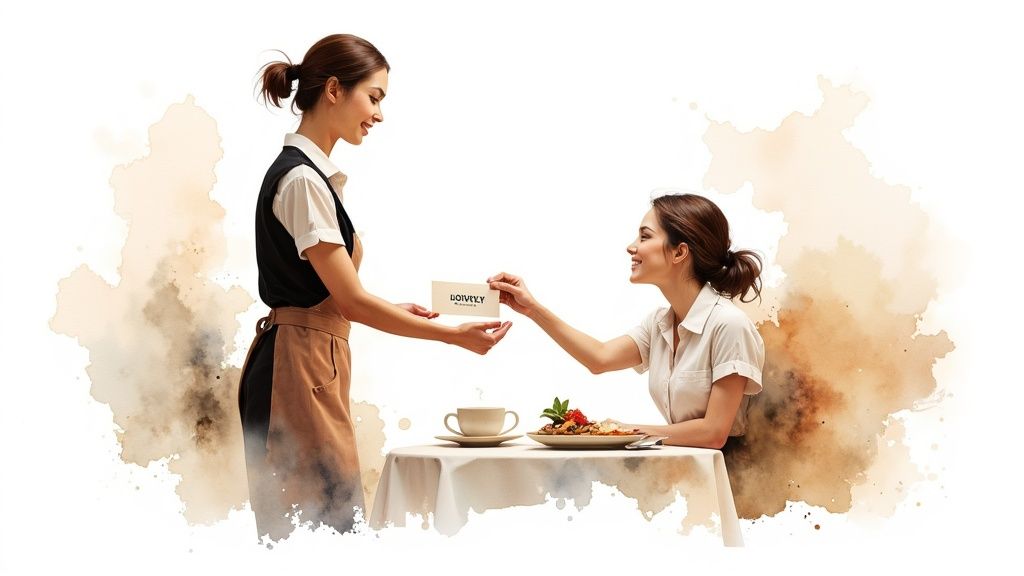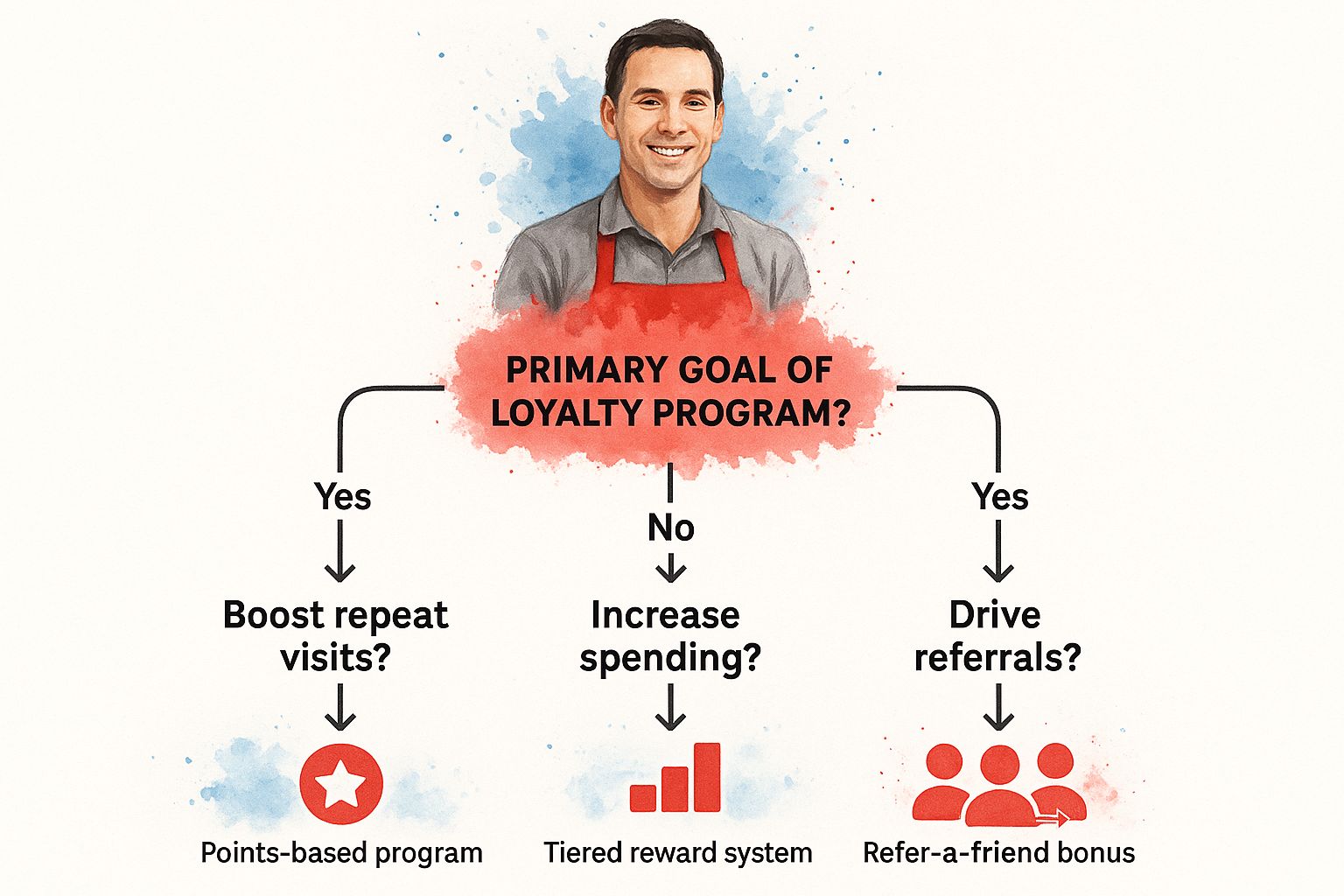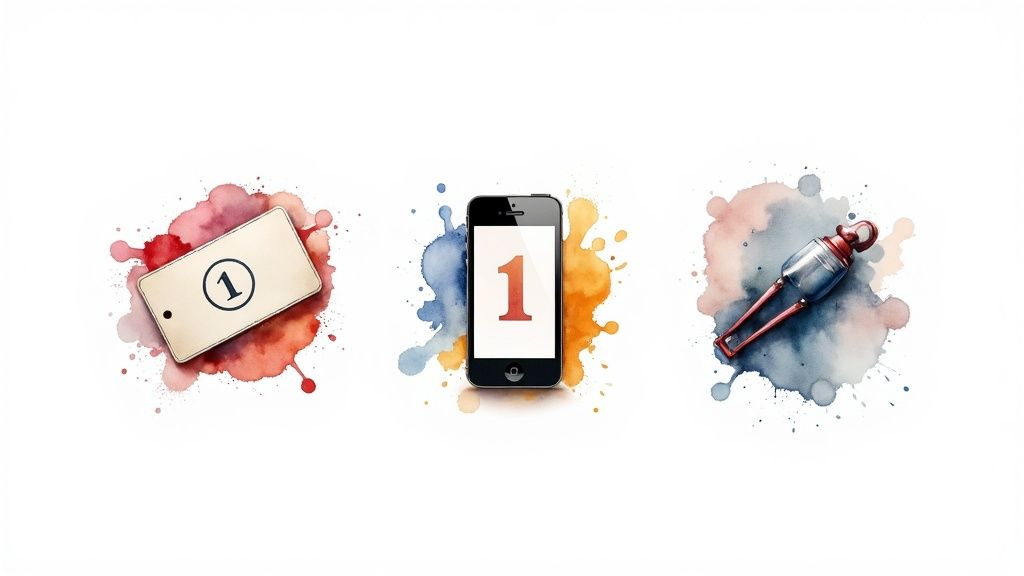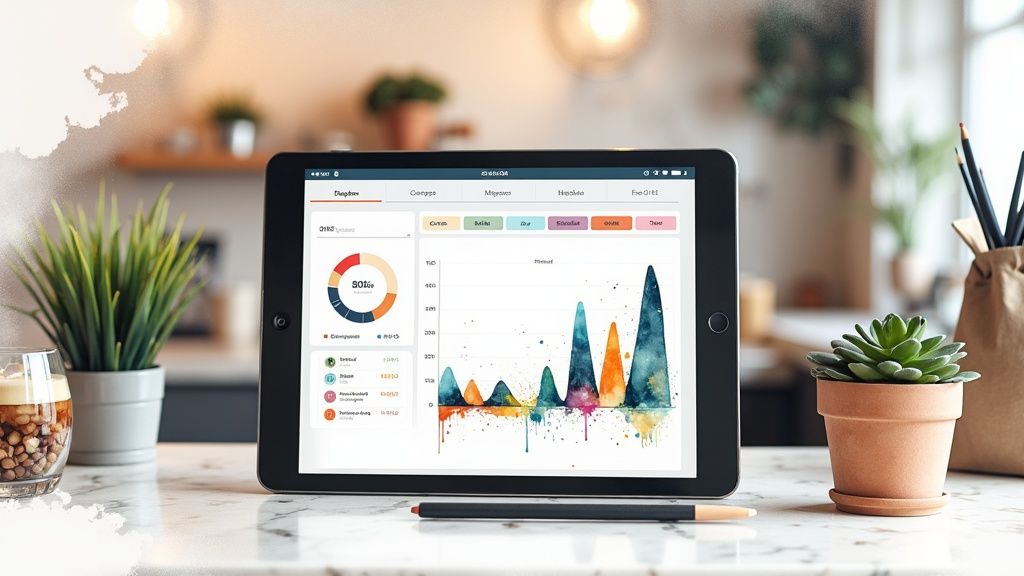Proven loyalty programs for restaurants to boost retention and sales

A loyalty program isn't just a marketing tactic; it's a core part of keeping your restaurant's doors open. It boosts visit frequency, nudges check averages higher, and turns casual visitors into predictable profit by rewarding the regulars who form the backbone of your business.
To be blunt, a loyalty program is a survival tool.
In an industry with razor-thin margins and competition on every corner, treating every customer like a one-time transaction is a losing game.
The big chains have this down to a science, but you have an advantage they can't match: a genuine connection with guests.
A good program builds on that connection. It’s your defense against a slow Tuesday night or a new spot opening down the street. It gives customers a tangible reason to choose you, every time. Acquiring a new customer costs five times more than keeping an existing one. Your loyalty program is your retention engine, and it directly fuels your bottom line.
Over the last decade, loyalty programs have moved beyond paper punch cards. By 2025, 82% of restaurant brands will have a loyalty program, making them a standard tool for growth. This isn't just a trend—it's what customers now expect. Diners anticipate being rewarded for their repeat business.
A modern program does more than offer a free appetizer. It gives you invaluable data on your most important customers, answering critical questions:
This information allows you to make smarter, faster decisions. Imagine you see a group of regulars always orders your weekly fish special. With a loyalty program, you can text them on Thursday with a sneak peek of this week's new menu items. That personal touch drives traffic and makes your guests feel valued.
A loyalty program is a communication channel that helps you understand and reward the customers who are the bedrock of your business. It lets you build a community, not just a customer list. This is all about implementing strategies to increase customer lifetime value. By focusing on the 20% of customers who likely drive 80% of your revenue, you build a stable foundation.
Deciding on your program's structure is a critical first step. The goal is to find a model that fits your restaurant's personality, protects your margins, and motivates guests to return. A high-volume QSR has different needs than a full-service bistro. Before getting bogged down in apps, get clear on what you want the program to achieve. Are you trying to boost visits on a slow Tuesday or increase check averages?
Your primary goal should be the deciding factor. The infographic below helps connect your main business objective to the most effective program type.

If your challenge is getting regulars to visit one more time per month, a simple points-based system is often best. If you want to increase check averages, a tiered system that unlocks better perks at higher spending levels provides a stronger incentive.
This is the classic "earn and burn" model. Customers earn points for every dollar spent, which they can redeem for rewards. For example, 100 points for a free coffee, 500 points for a free entrée. It’s straightforward, and many modern restaurant POS systems have this functionality built-in. The downside is that it can feel impersonal if not paired with great service.
A tiered system makes your best customers feel like VIPs. Guests unlock new levels of perks as their spending increases. A "Silver" tier might offer a free birthday dessert, while a "Gold" tier gets priority seating. This model creates a sense of status and exclusivity, a powerful motivator. The catch is that the perks for higher tiers must be valuable enough to justify the spending.
These programs reward more than just transactions. You can award points for actions like writing a review, sharing a post on social media, or referring a friend. It’s about rewarding engagement that helps your business grow. This approach is brilliant for building a genuine community, turning your most loyal customers into an active part of your marketing efforts.

Many loyalty programs miss the mark here. A free soda or a generic 10% discount feels cheap, not special. A great reward feels like a genuine thank-you. It must be valuable enough to bring someone back, but smart enough that it doesn't kill your thin margins.
The good news? Your POS sales data is a goldmine. Forget guessing—look at what people are already ordering.
Your goal is to find menu items with a high perceived value but a low food cost percentage. These are your loyalty program superstars. Think about that popular appetizer your kitchen can fire out quickly. It might sell for $12, which feels substantial to a guest, but only costs you $3 in ingredients. That’s a perfect candidate.
Here’s how to find these items on your menu:
This data-first approach takes the guesswork out of the equation. You're making a strategic investment in a future visit using an item you know is both desirable and affordable.
While free food is great, don't underestimate the power of experiences. They forge a deeper connection than a free dessert ever could and make your regulars feel like insiders. Research shows loyal customers spend 33% more per order and visit 1.5 times more frequently. Building this connection pays off. You can see more data by exploring the full research on restaurant loyalty trends.
Try mixing in perks that cost you next to nothing:
By combining margin-friendly food rewards with exclusive experiences, you create a program that feels generous without draining your profits.
You’ve built a great program. Now for the hard part: getting sign-ups.
A successful launch doesn't require a massive marketing campaign. For an independent restaurant, your team is your marketing department.
Before you print a single sign, get your staff bought in. Explain the why. This isn't just another task; it's about rewarding the regulars who keep the lights on. Make it a simple part of their routine, like asking, "Are you part of our rewards program? You get a free appetizer for signing up."
Your launch plan should be built around the touchpoints you already own. Aim for consistent, low-cost promotion.
Here’s a quick-win checklist for this week:
Your first offer has to be strong enough to cut through the noise. Think instant gratification. "Earn points toward a future reward" is weak. "Get a free order of our famous garlic knots right now" is compelling.
Choose a bonus with a high perceived value but a low food cost. You’re trading a low-cost item for a guest's contact info and their promise to come back. It's one of the smartest trades you can make.

A great loyalty program is an engine for business intelligence. It tells you who your best customers are and where to focus your energy. This data is your secret weapon for making smarter, more profitable decisions. This is where you move from guessing what customers want to knowing.
Forget who you think your best customers are. Your POS system should be able to report your top loyalty members based on spend and visit frequency. These are the people you need to protect at all costs. An analysis might reveal that your top 10% of loyalty members drive 40% of your program-related revenue. This is your priority group.
Blanket discounts are a waste of money. Loyalty data lets you run targeted promotions that change behavior. If your data shows a group of customers consistently orders a bottle of wine with dinner, send them an exclusive offer for a "Wine Wednesday" event. You're not throwing a discount into the void; you're inviting the right people to an experience they're primed to enjoy.
Research shows 57% of diners would spend more if a loyalty program were available. When guests feel seen, they become your best promoters. Data lets you stop marketing to the masses and start a conversation with your best customers. To get granular with your results, learn how QR codes and URL parameters can drive marketing ROI.
Your program's data can also give you direct feedback. Are members who order the new steak special coming back sooner than those who stick to the classics? That's a real measure of satisfaction. This information becomes a continuous feedback loop that helps improve the entire guest experience. Making sense of these analytics is why the right restaurant POS system can transform your business operations.
Jumping into a loyalty program brings up practical questions. Let's tackle the concerns we hear most often from independent owners.
The cost can vary wildly. A basic program integrated into your POS might have a small monthly fee. The real cost, however, isn't the software—it's the rewards you give away, and you control this completely.
Offer rewards with a high perceived value but a low food cost. A free order of garlic knots that costs you $1.50 in ingredients is smarter than a cocktail that kills your liquor margin. Budget between 1-3% of total sales for loyalty rewards to keep the program sustainable.
Forget vanity metrics like total sign-ups. The only numbers that matter are the ones that impact your bottom line. Success is about frequency and average check size.
To measure real ROI, track these key metrics:
If members visit more frequently and spend more each time, the program is paying for itself.
The market is flooded with options. For most independent restaurants, the best starting point is a system that integrates directly with your POS. This avoids operational headaches, keeps data in one place, and makes it simple for staff to manage during a busy service.
Ready to turn one-time guests into regulars without the operational headache? Peppr offers a loyalty program that integrates seamlessly with your POS, giving you the data you need to grow your business.
Discover how Peppr can help you build a smarter loyalty program.
A loyalty program isn't just a marketing tactic; it's a core part of keeping your restaurant's doors open. It boosts visit frequency, nudges check averages higher, and turns casual visitors into predictable profit by rewarding the regulars who form the backbone of your business.
To be blunt, a loyalty program is a survival tool.
In an industry with razor-thin margins and competition on every corner, treating every customer like a one-time transaction is a losing game.
The big chains have this down to a science, but you have an advantage they can't match: a genuine connection with guests.
A good program builds on that connection. It’s your defense against a slow Tuesday night or a new spot opening down the street. It gives customers a tangible reason to choose you, every time. Acquiring a new customer costs five times more than keeping an existing one. Your loyalty program is your retention engine, and it directly fuels your bottom line.
Over the last decade, loyalty programs have moved beyond paper punch cards. By 2025, 82% of restaurant brands will have a loyalty program, making them a standard tool for growth. This isn't just a trend—it's what customers now expect. Diners anticipate being rewarded for their repeat business.
A modern program does more than offer a free appetizer. It gives you invaluable data on your most important customers, answering critical questions:
This information allows you to make smarter, faster decisions. Imagine you see a group of regulars always orders your weekly fish special. With a loyalty program, you can text them on Thursday with a sneak peek of this week's new menu items. That personal touch drives traffic and makes your guests feel valued.
A loyalty program is a communication channel that helps you understand and reward the customers who are the bedrock of your business. It lets you build a community, not just a customer list. This is all about implementing strategies to increase customer lifetime value. By focusing on the 20% of customers who likely drive 80% of your revenue, you build a stable foundation.
Deciding on your program's structure is a critical first step. The goal is to find a model that fits your restaurant's personality, protects your margins, and motivates guests to return. A high-volume QSR has different needs than a full-service bistro. Before getting bogged down in apps, get clear on what you want the program to achieve. Are you trying to boost visits on a slow Tuesday or increase check averages?
Your primary goal should be the deciding factor. The infographic below helps connect your main business objective to the most effective program type.

If your challenge is getting regulars to visit one more time per month, a simple points-based system is often best. If you want to increase check averages, a tiered system that unlocks better perks at higher spending levels provides a stronger incentive.
This is the classic "earn and burn" model. Customers earn points for every dollar spent, which they can redeem for rewards. For example, 100 points for a free coffee, 500 points for a free entrée. It’s straightforward, and many modern restaurant POS systems have this functionality built-in. The downside is that it can feel impersonal if not paired with great service.
A tiered system makes your best customers feel like VIPs. Guests unlock new levels of perks as their spending increases. A "Silver" tier might offer a free birthday dessert, while a "Gold" tier gets priority seating. This model creates a sense of status and exclusivity, a powerful motivator. The catch is that the perks for higher tiers must be valuable enough to justify the spending.
These programs reward more than just transactions. You can award points for actions like writing a review, sharing a post on social media, or referring a friend. It’s about rewarding engagement that helps your business grow. This approach is brilliant for building a genuine community, turning your most loyal customers into an active part of your marketing efforts.

Many loyalty programs miss the mark here. A free soda or a generic 10% discount feels cheap, not special. A great reward feels like a genuine thank-you. It must be valuable enough to bring someone back, but smart enough that it doesn't kill your thin margins.
The good news? Your POS sales data is a goldmine. Forget guessing—look at what people are already ordering.
Your goal is to find menu items with a high perceived value but a low food cost percentage. These are your loyalty program superstars. Think about that popular appetizer your kitchen can fire out quickly. It might sell for $12, which feels substantial to a guest, but only costs you $3 in ingredients. That’s a perfect candidate.
Here’s how to find these items on your menu:
This data-first approach takes the guesswork out of the equation. You're making a strategic investment in a future visit using an item you know is both desirable and affordable.
While free food is great, don't underestimate the power of experiences. They forge a deeper connection than a free dessert ever could and make your regulars feel like insiders. Research shows loyal customers spend 33% more per order and visit 1.5 times more frequently. Building this connection pays off. You can see more data by exploring the full research on restaurant loyalty trends.
Try mixing in perks that cost you next to nothing:
By combining margin-friendly food rewards with exclusive experiences, you create a program that feels generous without draining your profits.
You’ve built a great program. Now for the hard part: getting sign-ups.
A successful launch doesn't require a massive marketing campaign. For an independent restaurant, your team is your marketing department.
Before you print a single sign, get your staff bought in. Explain the why. This isn't just another task; it's about rewarding the regulars who keep the lights on. Make it a simple part of their routine, like asking, "Are you part of our rewards program? You get a free appetizer for signing up."
Your launch plan should be built around the touchpoints you already own. Aim for consistent, low-cost promotion.
Here’s a quick-win checklist for this week:
Your first offer has to be strong enough to cut through the noise. Think instant gratification. "Earn points toward a future reward" is weak. "Get a free order of our famous garlic knots right now" is compelling.
Choose a bonus with a high perceived value but a low food cost. You’re trading a low-cost item for a guest's contact info and their promise to come back. It's one of the smartest trades you can make.

A great loyalty program is an engine for business intelligence. It tells you who your best customers are and where to focus your energy. This data is your secret weapon for making smarter, more profitable decisions. This is where you move from guessing what customers want to knowing.
Forget who you think your best customers are. Your POS system should be able to report your top loyalty members based on spend and visit frequency. These are the people you need to protect at all costs. An analysis might reveal that your top 10% of loyalty members drive 40% of your program-related revenue. This is your priority group.
Blanket discounts are a waste of money. Loyalty data lets you run targeted promotions that change behavior. If your data shows a group of customers consistently orders a bottle of wine with dinner, send them an exclusive offer for a "Wine Wednesday" event. You're not throwing a discount into the void; you're inviting the right people to an experience they're primed to enjoy.
Research shows 57% of diners would spend more if a loyalty program were available. When guests feel seen, they become your best promoters. Data lets you stop marketing to the masses and start a conversation with your best customers. To get granular with your results, learn how QR codes and URL parameters can drive marketing ROI.
Your program's data can also give you direct feedback. Are members who order the new steak special coming back sooner than those who stick to the classics? That's a real measure of satisfaction. This information becomes a continuous feedback loop that helps improve the entire guest experience. Making sense of these analytics is why the right restaurant POS system can transform your business operations.
Jumping into a loyalty program brings up practical questions. Let's tackle the concerns we hear most often from independent owners.
The cost can vary wildly. A basic program integrated into your POS might have a small monthly fee. The real cost, however, isn't the software—it's the rewards you give away, and you control this completely.
Offer rewards with a high perceived value but a low food cost. A free order of garlic knots that costs you $1.50 in ingredients is smarter than a cocktail that kills your liquor margin. Budget between 1-3% of total sales for loyalty rewards to keep the program sustainable.
Forget vanity metrics like total sign-ups. The only numbers that matter are the ones that impact your bottom line. Success is about frequency and average check size.
To measure real ROI, track these key metrics:
If members visit more frequently and spend more each time, the program is paying for itself.
The market is flooded with options. For most independent restaurants, the best starting point is a system that integrates directly with your POS. This avoids operational headaches, keeps data in one place, and makes it simple for staff to manage during a busy service.
Ready to turn one-time guests into regulars without the operational headache? Peppr offers a loyalty program that integrates seamlessly with your POS, giving you the data you need to grow your business.
Discover how Peppr can help you build a smarter loyalty program.
